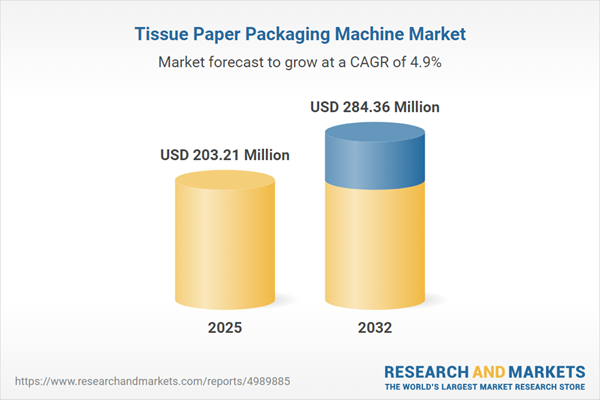Speak directly to the analyst to clarify any post sales queries you may have.
The tissue paper packaging machine market is advancing rapidly, driven by innovations in digitization, automation, and sustainability. Senior stakeholders must understand the forces at play to remain competitive and anticipate future shifts as new technologies and trade practices reshape global supply chains.
Market Snapshot: Growth and Emerging Dynamics
The Tissue Paper Packaging Machine Market expanded from USD 193.56 million in 2024 to USD 203.21 million in 2025 and is projected to increase at a CAGR of 4.92%, reaching USD 284.36 million by 2032. Strategic investment decisions are accelerating as advanced robotics, predictive maintenance, and material science innovation enable equipment to deliver higher operational agility. Intensified sustainability mandates and globalization of supply chains underscore the market’s complex trajectory for senior decision-makers.
Scope & Segmentation
- Machine Types: Cartoning machines, horizontal flow wrappers, labeling machines, shrink wrapping machines, vertical form fill seal systems.
- End Users: Contract packaging services, retail chains, tissue manufacturers.
- Automation Levels: Automatic, manual, semi-automatic systems.
- Applications: Carton packaging, case packaging, multipack packaging, rolls packaging (multi-roll and single roll subtypes).
- Packaging Materials: Foil (aluminum foil, laminated foil), paperboard (coated recycled board, solid bleached board), plastic film (biaxially oriented polypropylene film, polyethylene film).
- Geographic Regions: Americas (including North America and Latin America), Europe, Middle East & Africa (with detailed country coverage), Asia-Pacific (with detailed country coverage).
- Key Companies: Syntegon Technology GmbH, MULTIVAC Sepp Haggenmüller SE, PFM Group S.p.A., Barry-Wehmiller Hayssen Flexible Systems Inc., Rovema GmbH, Ilapak S.A., Emba Machinery Limited, Cama Group S.p.A., Paper Converting Machine Company (PCMC), GEA Group Aktiengesellschaft.
Key Takeaways
- The integration of smart factory solutions and real-time data analytics enables predictive maintenance and supports optimized throughput, reducing operational disruptions for converters and manufacturers.
- Shifts toward circular economy principles and eco-friendly packaging film alternatives are prompting collaborative product development between machinery suppliers and material scientists, aligning with tightening environmental regulations.
- Operational agility and modular machine architectures now distinguish top providers, empowering customers to adjust to varied production formats, diverse packaging sizes, and market-specific demands without significant delays or retrofitting.
- Regional differentiation is pronounced. The Americas emphasize automation pace and renewable material adoption, while EMEA prioritizes compliance and recycling infrastructure. Rapid urbanization in Asia-Pacific supports growth in multi-format and premium packaging solutions.
- Companies that offer digital aftermarket services, including remote diagnostics and benchmarking analytics, position themselves to secure recurring revenue and deepen client engagement across the equipment lifecycle.
Tariff Impact on Tissue Paper Packaging Equipment
Recent United States tariff schedules have prompted manufacturers and suppliers to revise sourcing approaches. These adjustments include nearshoring production and localizing assembly, balancing new cost structures with continued supply chain resilience. Expanded bonded storage and realigned logistics can ease immediate impacts but require adaptation in workforce training and inventory management. These factors directly influence procurement strategies and pricing models for automation investments, particularly among global and North American end users.
Methodology & Data Sources
This report synthesizes in-depth primary interviews with machine producers, users, and experts, complemented by secondary analysis of patents, trade journals, and technical publications. Proprietary databases were analyzed, including machine installations, service contracts, and aftermarket activity. All findings have been validated by a subject matter advisory panel to ensure data reliability and current relevance.
Why This Report Matters
- Enables informed decision-making on equipment upgrades, procurement, and market entry by revealing the latest trends and actionable insights in the tissue paper packaging machinery sector.
- Equips leaders with intelligence on how sustainability mandates, digitalization, and trade changes will affect capital allocation and supply chain contingencies within relevant geographies.
- Supports the development of differentiated service offerings and strategic partnerships in a sector shaped by rapid innovation and regional variation.
Conclusion
The tissue paper packaging machine market is defined by advancing technology, evolving regulations, and regional contrasts. Leaders able to leverage digital innovation, modularity, and sustainable practices will maximize growth opportunities and manage risk in a competitive landscape.
Additional Product Information:
- Purchase of this report includes 1 year online access with quarterly updates.
- This report can be updated on request. Please contact our Customer Experience team using the Ask a Question widget on our website.
Table of Contents
3. Executive Summary
4. Market Overview
7. Cumulative Impact of Artificial Intelligence 2025
Companies Mentioned
The companies profiled in this Tissue Paper Packaging Machine market report include:- Syntegon Technology GmbH
- MULTIVAC Sepp Haggenmüller SE
- PFM Group S.p.A.
- Barry-Wehmiller Hayssen Flexible Systems Inc.
- Rovema GmbH
- Ilapak S.A.
- Emba Machinery Limited
- Cama Group S.p.A.
- Paper Converting Machine Company (PCMC)
- GEA Group Aktiengesellschaft
Table Information
| Report Attribute | Details |
|---|---|
| No. of Pages | 198 |
| Published | October 2025 |
| Forecast Period | 2025 - 2032 |
| Estimated Market Value ( USD | $ 203.21 Million |
| Forecasted Market Value ( USD | $ 284.36 Million |
| Compound Annual Growth Rate | 4.9% |
| Regions Covered | Global |
| No. of Companies Mentioned | 11 |









